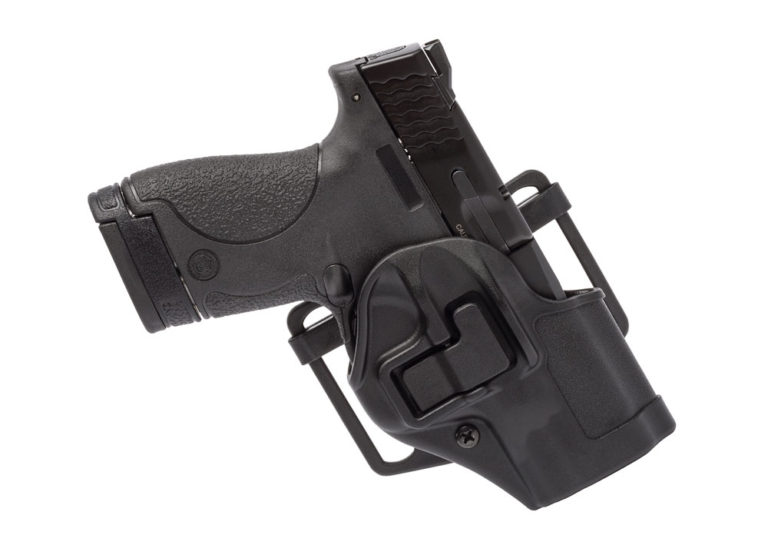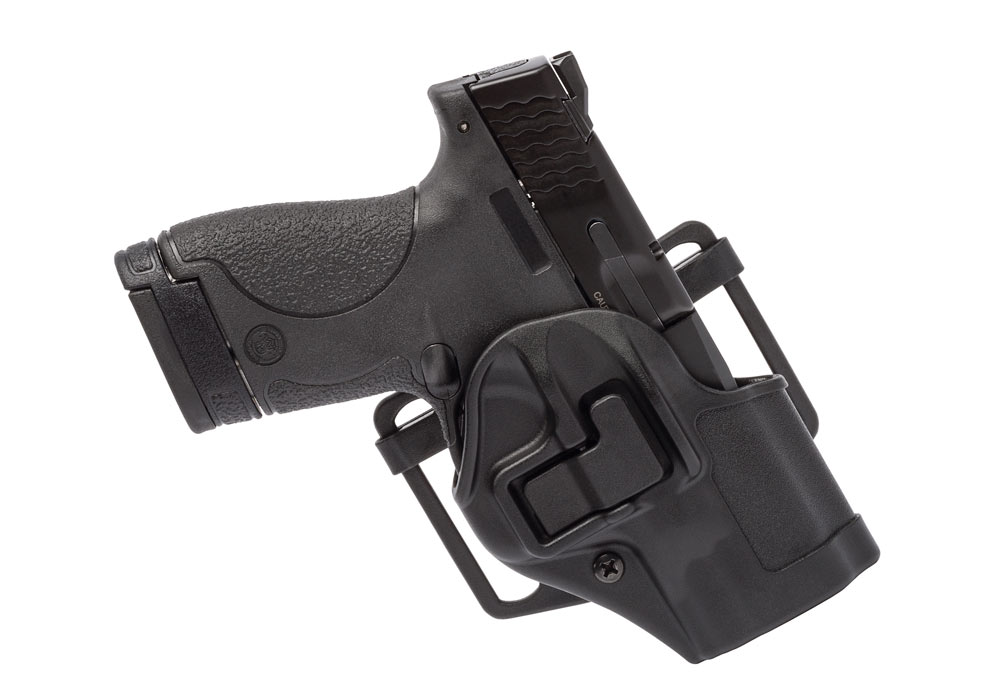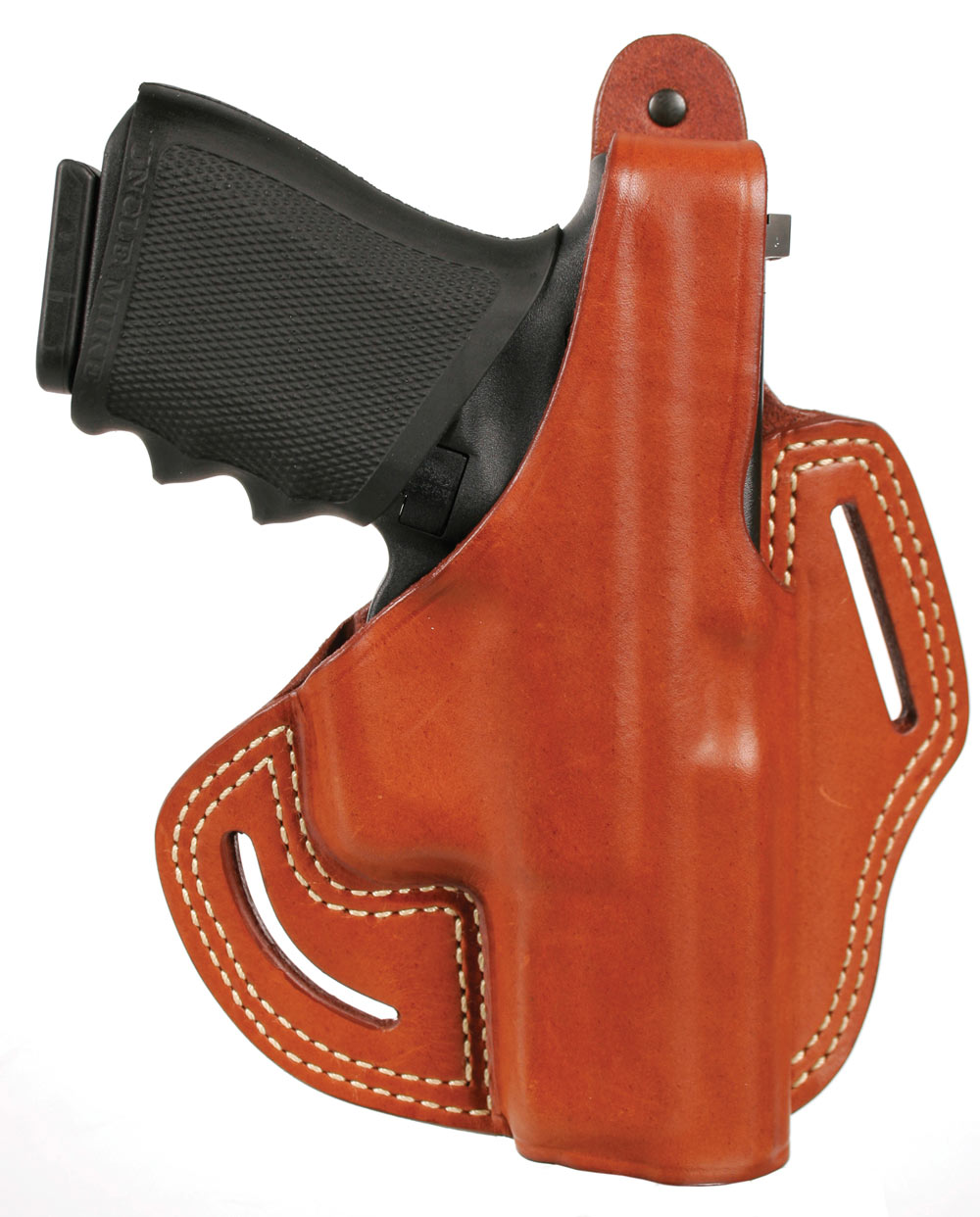

Holster retention is an important concept to grasp, whether you open or concealed carry. Here is a look at some general concepts on holster retention.
Friction
Leather scabbards have the innate ability to retain the handgun by good ol’ fashioned friction. Passive retention, as it’s sometimes called, is enhanced by the scabbard being molded to your make and model of gun, which increases contact across the gun’s exterior surface areas. If a leather holster is rough side in, that helps too.
Leather holsters achieve optimum retention immediately after the break-in period and, assuming the leather is of high quality, remain good for many years with occasional leather treatment. Avoid gimmicks like sticking your holster in water, or a warm oven, to adjust fit. These are more apt to ruin your good leather than help it. Not to mention making your kitchen stink like a glue factory.
Kydex, or polymer holsters aren’t affected by moisture, but also don’t naturally grip the handgun without some help from tension screws. By tightening or loosening these screws you can get just the right amount of friction for a basic level of security. The trouble is keeping the screws from loosening up throughout the day.
One Mechanism
One way to define a Level 2 retention holster is one which employs the same friction-based grip as Level 1, but with the addition of an active mechanical element, such as a hood, back strap, finger- or thumb-operated lever. Some believe that active-retention systems are only needed for open carry holsters — holsters used by armed citizens open carrying or on-duty law enforcement officers.
A gun grab, they say, isn’t likely if your gun is concealed. Others disagree. “People who haven’t learned to properly activate retention devices call them ‘suicide straps,’” writes Massad Ayoob in the Gun Digest Book of Concealed Carry, 2nd Edition. “They will tell you, ‘It’s concealed, so you don’t have to worry about someone grabbing it.’ Rubbish! Your attacker may know from previous contact with you that you carry a pistol, and even where you carry it. He may have spotted it when scoping you out. Or you might get into a fight and the other guy wraps his arms around your waist for a bear hug or throw and feels the gun, at which time the fight for the pistol is on.”

Two Mechanisms
By adding a second active element to a holster, plus passing the tension or friction test of Level 1 security, you get to Level 3 retention. Examples include Blackhawk’s Level 3 rig, which features a push-button activated hood shroud to shield the handgun from a grab attempt coming from the front or back. This level is almost never used for concealed carry as the doohickeys just make the thing too big and bulky for mere mortals to hide well. It is, however, used by law officers and open carry advocates, where the gun is exposed.
Three Mechanisms
A Level 4 holster takes these security measures one-step further, but it’s safe to say such rigs aren’t recommended for the armed citizen. If you need a level 4 holster you’re going into some serious stuff beyond the realm of what this little book can reasonably cover and certainly outside the purview of everyday carry for ordinary citizens.
Editor's Note: This article is an excerpt from The Comprehensive Guide to Concealed Carry Holsters.
Editor's Note: This post has been updated from its original version on 9/24/2014.
Out of the Holster: Top CCW Insights Revealed
- Concealed Carry Holsters for Women
- Best Concealed Carry Holster
- Best Pocket Holster – Options For Easy Everyday Carry
- Concealed Carry Shoulder Holsters – Best Up-Top Carry Options
- AIWB vs IWB Holster – Pros & Cons
- Concealed Carry Fanny Pack – Pros & Cons for Everyday Use

Next Step: Get your FREE Printable Target Pack
Enhance your shooting precision with our 62 MOA Targets, perfect for rifles and handguns. Crafted in collaboration with Storm Tactical for accuracy and versatility.
Subscribe to the Gun Digest email newsletter and get your downloadable target pack sent straight to your inbox. Stay updated with the latest firearms info in the industry.

![Best Concealed Carry Guns In 2025 [Field Tested] Wilson Combat EDC X9S 1](https://gundigest.com/wp-content/uploads/Wilson-Combat-EDC-X9S-1-324x160.jpg)


![Best 9mm Carbine: Affordable PCCs [Tested] Ruger Carbine Shooting](https://gundigest.com/wp-content/uploads/Ruger-Carbine-Shooting-100x70.jpg)
![Best AR-15: Top Options Available Today [Field Tested] Harrington and Richardson PSA XM177E2 feature](https://gundigest.com/wp-content/uploads/Harrington-and-Richardson-PSA-XM177E2-feature-100x70.jpg)

Why link to Safariland to describe retention level rating and then write an article that doesn’t come close to describing the standard Bill Rogers created? Safariland’s retention ratings have nothing to do with the number of retention devices on the holster like the article describes. Their holsters receive ratings based on how they perform against a gun grab test. Blackhawks so called “level 3” holster in reality is a level 0 holster because it can’t survive a gun grab attempt- regardless of the number of devices. It’s documented that the Blackhawks holster can break off from the belt as well as have both retention devices release if the gun is twisted in a certain manner- without touching either retention devices.
This article is inconsistent with actual retention ratings. Please educate yourself before misinforming readers.
It probably would have been best if Corey had done a little research and contacted Safariland about their retention rating system before writing about it.
That system, devised by Bill Rogers, the inventor of the modern security holster, has nothing to do with the number of mechanisms that the holster has. Corey’s interpretation is a common misconception in the industry. Safariland’s system is based on a series of hands-on performance tests in which the holster is physically attacked and tested. The holster must pass, in sequential order, each test to achieve a given level of rating. A holster can have several mechanisms on it and still not achieve any rating at all if it doesn’t pass the hands-on (literally) tests.
In point of fact, the Blackhawk Serpa holster pictured in the article will not pass even a Level I rating test, regardless of the number of mechanisms it might possess. The reason is that the holster must remain attached to the belt while attacker is pulling on it with a given amount of force. Because of its relatively small mounting area where the screws attach to the belt plate, the entire Serpa holster will pull off the belt when subjected to a Level I test. Unless, of course, the holster itself breaks, which has also been known to happen, when subjected to a hands-on test. Nor will an unreinforced leather holster, such as the Blackhawk slide holster pictured, pass a Level I test.
Here’s the link to Safariland’s explanation of the rating system. It includes a video of Bill visually demonstrating how the system works.
https://www.safariland.com/DutyGear/info/retention.aspx
Thanks for your comments! There were some extraneous statements that implied I was trying to describe the Safariland system. In fact, I was hoping to get across some general concepts about retention to the person new to holsters. The content has been revised to more accurately reflect this.
This “updated” versions is still very wrong and gives people a bad impression on kydex retention. A screw us not needed at all to have correct retention, which is usually in the trigger guard. The tell take “click” sound is that retention taking hold. Kydex makers also use different levels of retention such as thumb breaks and hoods.
It’s a very misinformative article, and you need to know what you’re talking about before publishing. Nearly the entire article is incorrect on information.